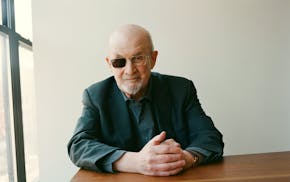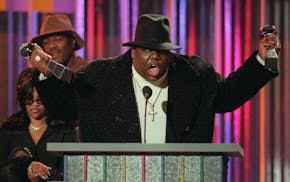When "How the West Was Won" galloped into town on March 14, 1963, the epic film hitched its wagon at the Cooper Theatre in St. Louis Park and didn't leave these parts for a stunning 88 weeks -- its longest run at any U.S. theater outside Hollywood.
People came from all over and paid the equivalent of up to $18 (in today's dollars) for the cinematic spectacle, often ordering tickets in advance to ensure a seat. "How the West Was Won" was one of only two feature films shot in Cinerama, and the 105-foot-wide screen of the Cooper -- the "Northwest Home of Cinerama" -- was the only place to see it.
"It was one of the few films I went to where the audience applauded when the drapes in front of the screen started to open all the way," said Joel Thom, 63, who was in his late teens when he saw the film at the Cooper. "And they kept opening and opening and opening, and then -- bam! -- 'How the West Was Won.'"
Added Thom, who became manager of the Cooper in the 1970s, "It was thrilling, just absolutely tingling, to have that experience because you really felt like you were at something very special."
A new DVD, out today after a six-year restoration, aims to re-create some of that magic for the first time on home video.
Until now, the greatest asset of "How the West Was Won" in theaters -- its Cinerama presentation -- was its biggest liability for home viewers. Cinerama films were shot using three synchronized side-by-side cameras to create three strips of film, a cumbersome process. In specially equipped Cinerama theaters such as the Cooper, the three films were projected in sync to create one giant image.
The Cooper's huge screen, which was curved 146 degrees, and the movie's seven-channel sound combined to create an unparalleled experience.
But the three-strip Cinerama process proved problematic when the film was shown in regular movie theaters, on TV and on home video. In widescreen presentations, the three panels created two distracting vertical lines in the composite picture, which was cropped on the sides. The panel join lines were visible in pan-and-scan presentations, too. Worse, the color was off in each panel, so the overall image quality wasn't uniform.
"Everywhere it's looked awful unless you saw it in a Cinerama theater," said George Feltenstein, Warner's senior vice president of catalog marketing.
Today's DVD (Warner, $21; $60 collector's edition) finally fixes all of those problems. In the most expensive project in Warner Home Video's history, the three strips were digitally blended frame by frame by frame -- nearly 700,000 total -- to create a seamless image devoid of the vertical lines. The combined image was scrubbed free of blemishes and color-corrected for uniformity. Finally, the image was presented uncropped and free of distortion anomalies in the film's original super-wide aspect ratio of 2.89:1 -- meaning the picture is 2.89 times wider than it is high. (Today's films are typically no wider than 2.35:1.)
The original seven-channel sound also has been restored, preserving the film's directional audio effects.
Better yet, the high-def Blu-ray version ($35) adds an innovative "SmileBox" presentation of the film -- besides the regular widescreen version.
"'SmileBox' is a term that was invented by David Strohmaier, who really is the godfather of this project and the godfather of renewal of interest in Cinerama," Feltenstein explained.
Looking somewhat like a horizontal concave lens -- "it smiles at the top and frowns at the bottom," Feltenstein said -- the presentation mimics the feeling of watching "How the West Was Won" on the old curved Cinerama screen. The illusion is most potent when viewed on a large home-theater screen at a closer-than-usual seating distance.
"If a home-theater enthusiast doesn't have a Blu-ray player at this point in time, they're not a home-theater enthusiast," Feltenstein said.
But viewers of the standard DVD can get glimpses of the SmileBox presentation in clips of other Cinerama films in the Strohmaier-directed "Cinerama Adventure." That feature-length documentary, which recounts the history of Cinerama, is the primary supplement on the DVD besides commentary by Strohmaier and other film scholars.
A grim outlook for 'Grimm'
Feltenstein said Warner has no plans to do a similar restoration of the other feature-length Cinerama film, "The Wonderful World of the Brothers Grimm," because it's not popular enough to justify the cost. Besides winning three Oscars and being nominated for five more, "How the West Was Won" featured an all-star cast that included Henry Fonda, Gregory Peck, Debbie Reynolds and John Wayne; actress Carroll Baker even came to town for the Cooper premiere. Other Cinerama films, such as "This Is Cinerama," were largely documentaries and travelogues.
Thom, who now lives in Fort Lauderdale, Fla., was excited at the prospect of the new DVD, which further re-creates a night at the Cooper by restoring two features of yore: an overture before the movie and an intermission with music halfway through to stretch and grab a snack. He even said he was considering upgrading to a Blu-ray player for the all-out experience of the SmileBox presentation.
"Oh, that would be wonderful," Thom said. "I'll have to have a group of friends over to have a 'How the West Was Won' party. We'll do the overture, intermission and cocktails this time."
Randy A. Salas • 612-673-4542

Salman Rushdie's 'Knife' is unflinching about his brutal stabbing and uncanny in its vital spirit
